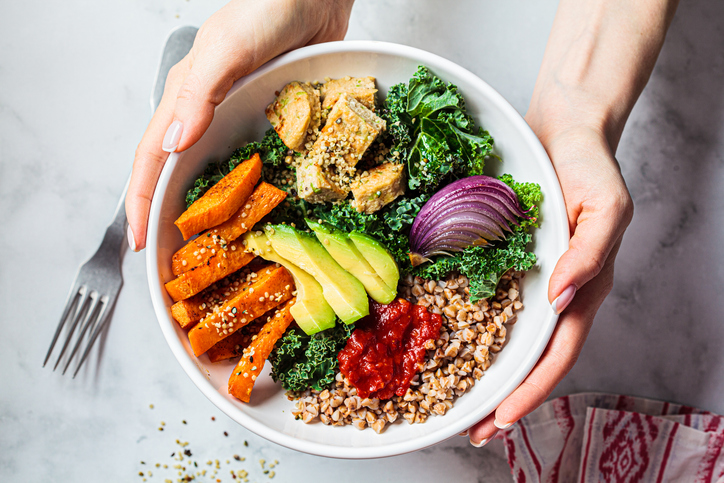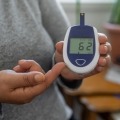Eating Vegan with Diabetes
By Eliza Skoler
 Can people with diabetes be vegan? How can you get started with a plant-based diet? Your guide to vegan diets for people with diabetes, plus some delicious recipes.
Can people with diabetes be vegan? How can you get started with a plant-based diet? Your guide to vegan diets for people with diabetes, plus some delicious recipes.
Maybe someone you know just became vegan, maybe it seems like many people around you are going meat-free, or maybe your healthcare professional just suggested that you consider a plant-based diet. Whether or not you’ve ever heard of – or met – a vegan, here’s what people with diabetes should know about following a vegan (or plant-based) diet.
What does it mean to be vegan?
People who follow a plant-based diet – and consume zero animal products – are considered vegan. This means they don’t eat anything that comes from animals, including meat, fish, dairy, eggs, honey, and more. Vegetarians, on the other hand, often avoid meat but may still eat things like milk or eggs.
Can people with diabetes be vegan?
Yes! In fact, a plant-based diet may actually be better for your physical health, mental wellbeing, and diabetes management. That said, there are some important things to consider if you have diabetes and want to switch to a plant-based diet.
What do vegans with diabetes eat?
 All sorts of things – vegetables and fruits, beans and nuts, whole grains, and more. There are many ingredients and recipes below to help you experiment and get started.
All sorts of things – vegetables and fruits, beans and nuts, whole grains, and more. There are many ingredients and recipes below to help you experiment and get started.
If you decide to eat a plant-based diet, it’s important that you still get all the vitamins and nutrients that your body needs. As with any meal or snack, you’ll want to balance carbohydrates, fat, protein, and fiber.
You may find yourself more hungry as your body adjusts to this new way of eating. Remember that you still need to watch your blood sugar levels, and that carbohydrates will still cause your blood sugar to spike. Eating protein and fiber with carbohydrates can slow carbohydrate digestion and help avoid blood sugar swings. The good news here is that vegan protein sources (beans, tofu, nuts and seeds) have a lot of fiber built right in.
Here are some basic carbohydrate guidelines for anyone with diabetes, whether or not you are eating animal products:
-
Reduce “spiky carbs.” Spiky carbs are foods that cause blood sugar levels to quickly increase and can create unpredictable swings in your glucose levels. Examples: cookies and cakes, ice cream, candy, bread and crackers, chips, breakfast cereal, pasta, soda, and fruit juice. Many of these items are processed and include added sugars – which can spike your blood sugar even more.
-
Focus on “slow-carb” and low-carb foods. Slow carbs are broken down more slowly in the body and have a more predictable effect on blood sugar levels. Slow carbs include vegetables that grow above the ground (like leafy greens, broccoli, tomatoes, and cabbage), beans, and some fruits. Low-carb foods usually have little effect on blood sugar, such as nuts and dairy products, and often contain protein and healthy fats.
You can find out more about nutrition for people with diabetes here.
Here’s a list of low-carb and slow-carb plant-based foods to get you started:
|
Low-Carb Foods |
Slow-Carb Foods |
|
|
How to get started with a plant-based diet
-
Talk to your healthcare professional. If you have diabetes, it’s important that you discuss major changes to diet with your healthcare team so that you can work together to monitor your health. You may need to adjust insulin doses or other medications to keep your blood sugar levels more stable.
-
Focus on non-starchy vegetables and plant-based protein. Fill your plate with vegetables and protein (like tofu, beans, or nuts), being sure to also always incorporate healthy fats (avocado, olive oil, nuts and seeds).
-
Ask your healthcare professional if you should take any vitamins or supplements. Sometimes people don’t get enough key nutrients when they switch from eating meat to a plant-based diet, so you may need to consider taking vitamin B12 or B6, niacin, iron, calcium, omega-3 fats, iodine, or zinc.
-
Introduce new foods slowly. If you’ve never eaten beans before, don’t start day one of being vegan with three meals of beans. Since you don’t know how new foods might affect your blood sugar levels, try new foods in moderation and make sure to monitor your blood glucose along the way.
-
Check your food labels. In general, processed foods may contain ingredients that you’re trying to avoid – whether that’s added animal products (like dairy, whey, gelatin, or eggs) or sweeteners that will spike your blood sugar. Make sure to read the ingredient list to know what you’re putting into your body.
Vegan recipes for people with diabetes
It can sometimes feel like a tall order to find prepared food that is plant-based, low in carbs, unprocessed, and tasty. So if you decide to try being vegan, you’ll probably want to experiment with cooking.
Here are some great vegan recipes from diaTribe writer Catherine Newman:
-
Tofu is packed with protein. Try Grilled Tofu Salad with Spicy Peanut Dressing, Flavor-Saturated Tofu, Roasted Tofu and Brussels Sprouts with Ginger Vinaigrette, or Tofu, Broccoli, and Radishes with Curried Peanut Sauce.
-
Cauliflower rice is a great low-carb substitute for rice (and it’s packed with fiber and nutrients). It also pairs with tofu dishes.
-
Zucchini spaghetti is another low-carb, vegetable alternative to pasta.
-
Mason jar salads are a helpful on-the-go meal (just leave out the cheese).
-
New vegetable sides and salads can be a good way to mix things up. Try Lemony One-Pan Green Beans, Best Roasted Vegetables, Bright Roots Slaw (use the mason jar vinaigrette instead of mayonnaise), or Collapsing Cabbage.
-
If you’re looking for some protein-rich snacks, try Lemony Hummus, Basic Edamame, or Overnight Berry Chia Pudding.
The internet is vast and you’ll definitely be able to find more recipes – just remember to eat plant protein and vegetables, incorporate healthy fats, and eat carbs that won’t spike your blood sugar. Bon appetit!








